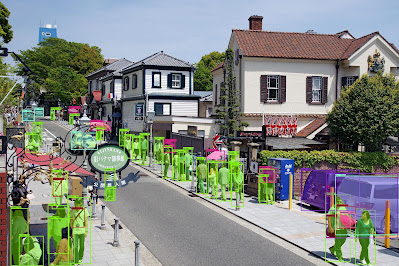Which Jupyter Notebook Service Should I Use?
We recommend starting off with Gradient’s free Community Notebooks feature. With free GPUs and CPUs, storage, uninterrupted service, an intuitive UI, ML project templates, and much more, it’s hard to imagine a use case where Gradient wouldn’t fit the bill.Dive in with a free GPU-backed Jupyter notebook (free account, free everything), fork one of many ML project templates (and run it for free from your own account), or check out the FAQ.
Qu'est-ce que Colab ?
https://colab.research.google.com/Colab (ou "Colaboratory") vous permet d'écrire et d'exécuter du code Python dans votre navigateur avec
- Aucune configuration requise
- Accès sans frais aux GPU
- Partage facile
Les notebooks Colab vous permettent d'utiliser, dans un même document, du code exécutable, du texte enrichi, des images, du code HTML, du code LaTeX et bien plus. Lorsque vous créez des notebooks Colab, ils sont enregistrés dans votre compte Google Drive. Vous pouvez facilement les partager avec vos collaborateurs ou vos amis, qui peuvent alors y apporter des commentaires ou même les modifier. Pour en savoir plus, consultez la page Présentation de Colaboratory. Pour créer un notebook Colab, utilisez le menu "Fichier" ci-dessus ou le lien Créer un notebook Colab.
Les notebooks Colab sont des notebooks Jupyter hébergés par Colab. Pour en savoir plus sur le projet Jupyter, consultez le site Web jupyter.org.
Science des données
Colab vous permet de tirer pleinement parti des bibliothèques populaires Python pour analyser et visualiser des données. La cellule de code ci-dessous utilise numpy pour générer des données aléatoires et matplotlib pour les visualiser. Pour modifier le code, cliquez simplement sur la cellule.Machine learning
Colab vous permet d'importer un ensemble de données d'images, d'entraîner un classificateur d'images sur cet ensemble et d'évaluer le modèle, tout cela avec quelques lignes de code. Les notebooks Colab exécutent ce code sur les serveurs cloud de Google. Vous avez donc à votre disposition toute la puissance du matériel Google, y compris les GPU et TPU, quelle que soit la puissance de votre ordinateur. Vous n'avez besoin que d'un navigateur.Colab est très largement utilisé par la communauté du machine learning, par exemple dans les applications suivantes :
- Premiers pas avec TensorFlow
- Développement et entraînement de réseaux de neurones
- Expérimentation avec les TPU
- Dissémination de la recherche en IA
- Création de tutoriels
exemple
Mask R-CNN Image Segmentation Demo
This Colab enables you to use a Mask R-CNN model that was trained on Cloud TPU to perform instance segmentation on a sample input image. The resulting predictions are overlayed on the sample image as boxes, instance masks, and labels. You can also experiment with your own images by editing the input image URL.
About Mask R-CNN
The Mask R-CNN model addresses one of the most difficult computer vision challenges: image segmentation. Image segmentation is the task of detecting and distinguishing multiple objects within a single image. In particular, Mask R-CNN performs "instance segmentation," which means that different instances of the same type of object in the input image, for example, car, should be assigned distinct labels.
COCO index mapping
ID_MAPPING = {
1: 'person',
2: 'bicycle',
3: 'car',
4: 'motorcycle',
5: 'airplane',
6: 'bus',
7: 'train',
8: 'truck',
9: 'boat',
10: 'traffic light',....
alternatives?
Gradient
Gradient is an end-to-end MLOps platform that includes a free hosted Jupyter notebook service, with many options for pre-configured environments and free GPUs and CPUs.https://gradient.paperspace.com/free-gpu
Gradient simplifies developing, training, and deploying deep learning models. It’s comprised of a web UI, CLI, and SDK. One of the great things about Gradient is that it provides valuable functionality for beginners to professionals, with an intuitive web UI and extremely low barrier to entry.
example
This tutorial will walk you through image segmentation using a modified U-Net on the Oxford-IIIT Pet Dataset (created by Parkhi et al).
Image segmentation involves training a neural network to output a pixel-wise mask of an image. Each pixel is given a label which determines if it belongs to the object in that image, or not.
The Oxford-IIIT Pet Dataset consists of images, their corresponding labels, and pixel-wise masks. These masks are essentially labels for each pixel, which fall into three categories:
- Class 1 : Pixel belonging to the pet.
- Class 2 : Pixel bordering the pet.
- Class 3 : Surrounding pixel.
Kaggle
Kaggle is another Google product with similar functionalities to Colab. Like Colab, Kaggle provides free browser-based Jupyter Notebooks and GPUs. Kaggle also comes with many Python packages preinstalled, lowering the barrier to entry for some users.On the other hand, many users note that Kaggle kernels tend to be a bit slow (albeit still faster than Colab).



No comments:
Post a Comment